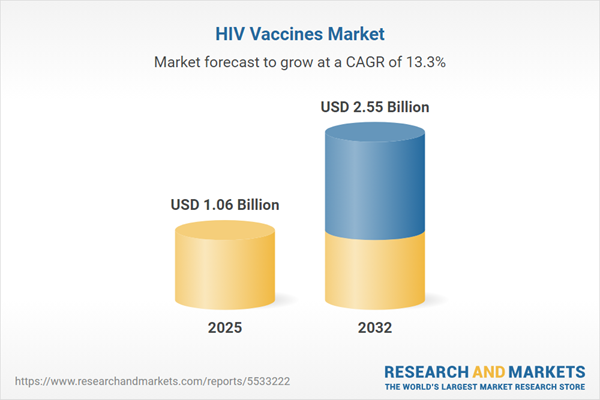Speak directly to the analyst to clarify any post sales queries you may have.
The HIV Vaccines Market is advancing rapidly as innovation, growing global demand, and responsive regulatory frameworks redefine how organizations approach strategy and operational resilience. Senior executives seeking to drive growth must proactively assess market changes and reallocate resources to maintain competitiveness.
Market Snapshot: Current Dynamics in the HIV Vaccines Market
Between 2024 and 2025, the HIV Vaccines Market expanded significantly, rising from USD 940.05 million to USD 1.06 billion, which corresponds to a 13.29% compound annual growth rate. This period of accelerated growth highlights robust investment in vaccine research, with market drivers including the evolution of immunogen design, adoption of digital health technologies, and modernized regulatory frameworks. These factors have prompted organizations to revise their operational plans, strengthen supply chain capabilities, and initiate new partnerships to remain agile. The dynamic nature of the market positions organizations to capitalize on emerging opportunities and challenges alike.
Scope & Segmentation of the HIV Vaccines Market
The market’s comprehensive segmentation enables senior leaders to align investment, R&D, and supply chain strategies with the evolving landscape. Strategic segmentation factors include:
- Vaccine Types: Both preventive and therapeutic vaccines address varying patient profiles. Inactivated, live attenuated, recombinant protein, and virus-like particle platforms collectively serve broad public health and treatment objectives.
- Technologies: DNA-based, mRNA, self-amplifying mRNA, peptide-based, and viral vector approaches underpin the drive for scalable vaccine manufacturing and refined immune responses.
- Routes of Administration: Intramuscular, intranasal, and subcutaneous vaccine delivery methods enhance clinical application and expand access to populations with diverse healthcare needs.
- End Users: Clinics, hospitals, research institutions, and pharmaceutical manufacturers play essential roles in clinical advancement, regulatory engagement, and extending product access.
- Distribution Channels: Direct sales, digital platforms, and pharmacy networks support tailored delivery approaches and expanded market penetration at regional and global scales.
- Geographical Regions: The Americas, Europe, Middle East & Africa, and Asia-Pacific each present unique demand drivers, infrastructure maturity, and compliance requirements that influence distribution and adoption strategies.
- Key Companies: Major industry players include Johnson & Johnson, Moderna, BioNTech, GlaxoSmithKline, Sanofi, Merck, Pfizer, Novavax, CureVac, and Bavarian Nordic, all leveraging specialized expertise to foster collaboration and continuous innovation.
Key Takeaways: Strategic Insights for Senior Leaders
- Adoption of flexible vaccine platforms enables organizations to adapt R&D resources and respond quickly to scientific and regulatory developments.
- Intensifying investment from both public and private sectors is amplifying vaccine pipelines and encouraging strategic cross-industry partnerships across the value chain.
- Ongoing collaboration among companies, governments, research bodies, and advocacy groups is fostering regulatory adaptability and accelerating progress from clinical development to market introduction.
- Digital health technology integration, including advanced analytics, is supporting improved regulatory preparedness and informed product launch execution.
- Adapting supply chain operations to address localized and regional needs helps safeguard continuity and minimize disruptions.
- Regionally tailored compliance and access strategies build organizational flexibility and resilience, strengthening competitiveness in a diverse regulatory environment.
Tariff Impact: Navigating the 2025 U.S. Regulatory Shift
Anticipated changes to U.S. tariffs will increase costs for essential vaccine materials and production equipment. Stakeholders are responding by investing in domestic production and fortifying in-country logistics networks. These measures are designed to maintain supply continuity, support regulatory compliance, and limit exposure to evolving policy conditions.
Methodology & Data Sources
This report synthesizes insights from industry experts, advisory boards, and peer-reviewed publications. Analysis draws on official regulatory databases, global clinical trial reviews, and patent evaluations to inform actionable and robust strategic planning.
Why This Report Matters
- Gives senior leaders actionable guidance to inform R&D strategy while aligning with regulatory and technological trends in the HIV Vaccines Market.
- Strengthens investment decisions with data-driven analysis of market segmentation and technology adoption, supporting effective risk management.
- Equips organizations with scenario-based planning resources to build operational resilience amid evolving healthcare landscapes and business uncertainties.
Conclusion
Investing in cutting-edge technology and agile regulatory strategies positions organizations for sustained success in the HIV Vaccines Market. Future-focused leadership is key to achieving enduring value and growth within this vital sector.
Additional Product Information:
- Purchase of this report includes 1 year online access with quarterly updates.
- This report can be updated on request. Please contact our Customer Experience team using the Ask a Question widget on our website.
Table of Contents
3. Executive Summary
4. Market Overview
7. Cumulative Impact of Artificial Intelligence 2025
Companies Mentioned
The companies profiled in this HIV Vaccines market report include:- Johnson & Johnson, Inc.
- Moderna, Inc.
- BioNTech SE
- GlaxoSmithKline plc
- Sanofi S.A.
- Merck & Co., Inc.
- Pfizer Inc.
- Novavax, Inc.
- CureVac N.V.
- Bavarian Nordic GmbH
Table Information
| Report Attribute | Details |
|---|---|
| No. of Pages | 187 |
| Published | October 2025 |
| Forecast Period | 2025 - 2032 |
| Estimated Market Value ( USD | $ 1.06 Billion |
| Forecasted Market Value ( USD | $ 2.55 Billion |
| Compound Annual Growth Rate | 13.2% |
| Regions Covered | Global |
| No. of Companies Mentioned | 11 |









